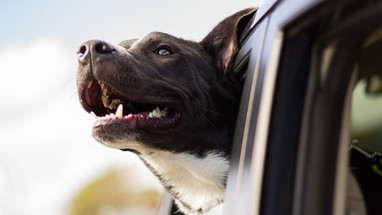Dog Hates Riding in the Car
Q: Our Golden Retriever puppy, Samuel, hates going on car rides. He looks queasy, pants and drools uncontrollably, and often throws up if there are a lot of turns or if the travel is stop and go. The problem has continued to get worse. Now, Samuel puts on the brakes and refuses to enter the car whenever we ask him to go on a trip. Sometimes we pick him up and force him to enter. However, we feel guilty making him do something that makes him feel so uncomfortable. He is otherwise a very pleasant and fun loving dog. We prefer that he willingly join us on trips, rather than having to leave him at home or force him into the car. Is there anything we can do to get him to enjoy car travel or at least tolerate riding in the car?
A: Most dogs love riding in the car. When the rear door is open they eagerly leap onto the back seat to join their owners for an excursion.
However, a significant minority of dogs despises automobile travel. Due to enduring motion sickness or an imprint from a prior episode(s) of motion sickness, the dogs may stubbornly refuse to enter a vehicle. In severe cases, they may even become fear aggressive toward the owner if the owner forcefully insists that the noncompliant dog come along for a ride. In anticipation of entering a vehicle or during travel, dogs who are experiencing or who have experienced motion sickness may exhibit full-blown panic attacks that include accelerated respiration, rapid pulse, drooling, and trembling. They may become catatonic or stuporous from fear. In addition or alternatively, dogs that experience the physical and/or psychological effects of motion sickness may become physiologically nauseous and vomit, which makes for an unpleasant cleanup at the completion of a journey. Certainly, when a dog routinely exhibits motion/car-sickness, a joint human-canine vehicle expedition is an odious travail for both the human and the pet.
Motion sickness usually begins during puppyhood. The cause may be physiological or behavioral or a combination of the two.
The most common physiological cause is related to the vestibular system of the inner ear. The vestibular system interprets rotational movements and linear acceleration to provide equilibrioception, balance, and spatial orientation. In a situation where a dog begins car travel before the vestibular system is adequately developed or when the vestibular system is improperly developed motion sickness is a possible result.
Some dogs will outgrow motion sickness. However, in other cases, even though the initial origins of the behavior are no longer pertinent, fearful behavioral imprints psychosomatically cause the symptoms to endure. Moreover, due to disease, trauma, or congenital defects that affect the vestibular area, some dogs may permanently have issues with motion, balance, spatial orientation, and equilibrium in a manner that affects the dogs’ ability to physically and psychologically accept automobile travel.
In other cases, the original cause may be purely psychological. Some puppies may develop car phobia and resultant motion sickness even when their vestibular system develops on schedule and develops properly. Dogs are outstanding at learning from classically conditioned sequential associations. Consequently, if car travel frequently equates to arrival at an unpleasant destination, such as a veterinary visit where the dog will be poked, prodded, restrained, and injected, then the dog may develop anxious, fearful, or phobic panic-responses or nausea during the ride or even before the ride begins. The preceding is especially likely when a dog makes frequent trips to the veterinarian during puppyhood, soon after adoption, or while being treated for a prolonged illness or condition. The preceding is less probable when many fun jaunts (training, play dates, dog park) are interspersed amongst only a few, infrequent unpleasant destinations.
Regardless of the origin of a dog’s motion sickness or car-related anxiety, we highly recommend promptly addressing the condition, as the longer motion/car-sickness festers, the more difficult it is to resolve.
Fortunately, there are a number of solutions that alone or in combination may minimize or eliminate the symptoms of motion sickness, regardless of whether the present cause is primarily physiological or psychological.
Facility Modification Have your dog ride in a crate or restrained by a seat belt, which should reduce motion and increase his perception of security. Have your dog wear a “Calming Cap,” which you can purchase from CPT or online. The Calming Cap will reduce the amount of visual stimulation he/she receives. Block the side windows alongside the seat level where he/she rides. Motion perception during car travel is greatest when the rider looks sideways, rather than frontward. Lower the side rear windows slightly, which may better adjust internal compartment air pressure to your dog’s liking. Keep the car A/C on, so that your car is cool and well ventilated. A poorly ventilated or hot car is more likely to provoke nausea.
Medication There are antihistamines (Dramamine, Benadryl, Chlorpheniramine, Promethazine, Cyclizine), anti-nausea/anti-emetics (Scopolamine, Mirtazapine), and anti-anxiety drugs ( Diazepam/Valium) that may reduce or eliminate motion sickness and/or the accompanying symptoms. Please confirm with your veterinarian regarding the safety, appropriateness, and dosage relative to your dog, regardless of whether the medication is available over the counter or exclusively through prescription.
Preparation Do not feed your dog prior to car trips or feed her a reduced portion.
Behavior Modification After placing your dog in the car, give her a bone or other stimulating chew item, so that she may better redirect focus from the car/drive to the pleasant emotions prompted by the chew item.
Implement counterconditioning and systematic desensitization drills that gradually get your dog comfortable with car travel. First, try feeding your dog in the car while all four doors are open and the car is stationary. Then, systematically progress to 3 doors open, 2 doors open, 1 door open, and all doors closed while the car remains stationary. Start with your dog remaining in the car for only 5 seconds. Then, gradually lengthen the time that your dog remains in the stationary vehicle. Alternative to or in addition to feeding you may elect to redirect your dog with a chew item or a toy. Only allow her to exit the vehicle if she appears composed. Don’t positively reinforce her for panic. However, also don’t extend the time to a length where panic is likely to occur. Only increase the time if your dog regularly appears relaxed at a shorter interval. Once your dog is composed for 5 minutes in a stationary vehicle with all the dogs closed, start the engine, the let the dog leave the car. If all goes well, in your next session, drive up and down the driveway, and then let your dog depart the car. In the final stages, gradually increase the duration of your travel.
Although motion/car-sickness is a condition that may lower the quality of life for you and your dog and that may limit the amount and/or type of activities you engage in with your dog, there are a number of potentially potent solutions. If you observe motion/car sickness, first determine the most probable causation. Then, immediately begin a solution plan by speaking to your veterinarian about pharmaceutical options and by implementing the treatment plan described above. If you require assistance in diagnosing the source of the problem or in implementing any of the above solutions, we highly recommend contacting a CPT behavior modification expert for an in-home private lesson.
© Copyright Mark Spivak and Comprehensive Pet Therapy, Inc., June 2011, Revised September 2011. All rights reserved.



